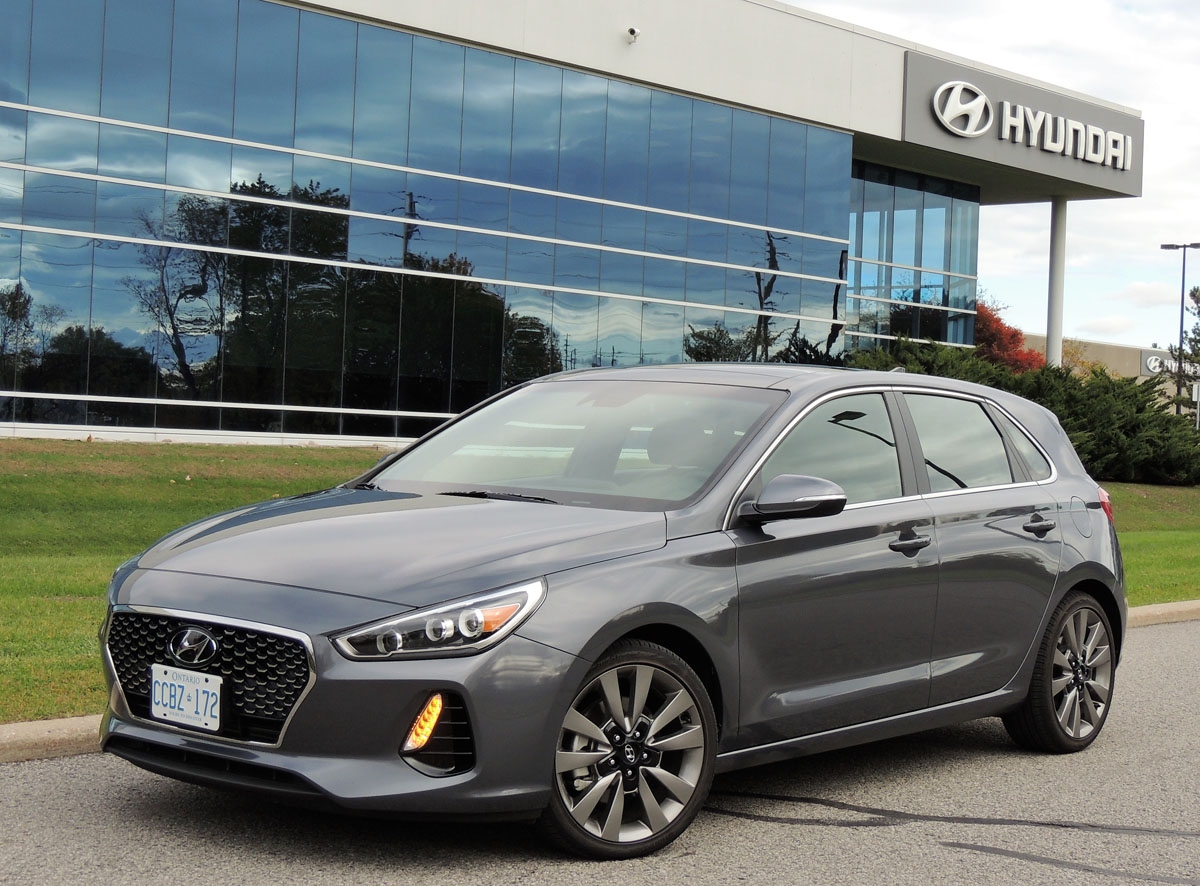
Hyundai charges ahead with new green motoring lineup
Photos by Neil Moore / Feature image: Hyundai has done nothing radical in designing its new EV. The Ioniq is an attractive compact hatchback that can travel up to 200 km on a full charge.
There’s no guarantee of success in being first to market, and in terms of hybrids and electric vehicles, Hyundai has been in no hurry.
They waited until 2011 to launch the Sonata Hybrid, and while competitors continued scrambling to electrify their lineups, Hyundai appeared content with a single nameplate. Until now.
Their recently-released Ioniq is actually a trio of new models: hybrid (HEV), plug-in hybrid (PHEV) and electric (EV). All have nearly identical sheet metal and interiors, with the more obvious differences being in the grille, tail lights and standard-equipped alloy wheels.
It’s a hatchback, but doesn’t look like one, partly because its large back window is split by the rear spoiler. But it’s more practical than a sedan, with 750 litres of cargo space in the HEV, 650 in the EV.
Overall, Ioniq is roughly the size of an Elantra, with loads of rear seat legroom and a passenger cabin that feels mid-size. And to achieve it, designers have been able to maintain a sporty silhouette that slips through the wind with a drag coefficient of 0.24. Saving the planet needn’t involve frumpy styling.

But it does mean fuel economy should be top drawer, and here the newcomer claims best-in-class status. The hybrid’s 4.1 litres/100 km (combined) tops Prius at 4.5 L/100km; ditto for the EV’s 1.7 Le/100 km that edges the uber-efficient Chevrolet Bolt at 2.0 Le.
Like all electrified vehicles, Ioniq’s efficiency comes at a cost. Trim levels span $24,299 to $31,749 for the hybrid, and $35,649 to $41,849 for the EV. The PHEV will be coming in October, with MSRPs available closer to release date. Pricey? Sure, but keep in mind that electric vehicles in Ontario are eligible for significant rebates – up to $14,000 for EVs, and up to $8,460 for PHEVs. Check the MTO website for details.
Charging stations are also eligible for incentives, which is key as you’ll need a Level 2 (220-volt) charger to live happily with an EV. Sure, you can plug into a regular 110-volt household outlet, but it’ll take you from flat to the full in a tardy 24 hours. The Level 2 unit will get you there in 4.5. Plug in when you arrive home from work, and you’ll be topped up by bedtime.
For those lucky enough to have access to a Level 3 ‘fast charger,’ a “fill up” takes just over 30 minutes.
The PHEV, with its 40-km range, will spend less time on the charger, which is no surprise as its 8.9 kWh battery requires less juice than its 28 kWh EV sibling.
I drove the Ioniq EV and hybrid back-to-back, and although they look alike, driving dynamics were anything but.
My first week was in the electric. Having tested other EVs, I expected its 200-km range to be another case of over promising and under delivering. Unless you switch off all accessories and find a good tailwind.
So I was surprised when my first errand – a 16-km trip to deliver my son to his co-op assignment – depleted only 9 km of range. Sure, I was running just fan and radio, but that’s thrifty by any standard.
Helping spare my range was Ioniq’s ‘Eco’ drive mode, which limits throttle response and provides maximum regenerative braking. Lift the accelerator, and without the brake pedal, it coasts quickly to a stop.
The other two drive modes, Normal and Sport, dial down the regen, or you can use a pair of steering wheel paddles that look but don’t operate like those of a typical gas burner. Flick the right paddle for freer coasting and the left for more drag and energy recapture.
Holding on to each electron soon becomes a personal quest, not just to minimize charging stops, but if you’ve plugged in for free, to see how far you can travel on someone else’s dime. Distance will drop once you start turning on accessories, so “doing without” becomes part of the challenge.
Mornings with the EV were chilly, so I ‘treated’ myself to the heater. This normally gobbles power, but if you order the $1,200 Cold Climate Package (which comes standard in top-trim Limited models), its heat pump is remarkably efficient. A full charge brought my Ioniq to a higher-than-expected 215 km; the heat pump dropped it to a still reasonable 201.
On the downside, Eco mode is a bit sluggish. But put it in Sport, and despite its modest 118 horsepower, Ioniq’s 218 lb/ft of torque can immediately be felt.
Performance won’t match the Bolt’s 266 lb/ft or its 6.5-second zero-to-100 km/h sprint, but it’s quicker than most competitors. You may even manage a chirp or squawk when accelerating through a turn, but that’s likely due to the low rolling-resistance tires.
Handling is also better than expected for this kind of ride. I can rattle on about how the EV gets a torsion beam instead of the hybrid’s multilink rear suspension, but most buyers won’t notice or care. I will point out that its underseat battery placement results in a low centre of gravity, which makes for increased stability in the turns. Better than the HEV, which leans more in hard cornering.
The hybrid’s power comes from a 16-valve 1.6-litre four cylinder with gasoline direct injection (104 hp, 109 lb/ft of torque) in combination with a 43-hp electric motor (125 lb/ft). This is mated to a six-speed ‘EcoShift’ dual clutch transmission.
I like DCTs, but don’t expect this one to fire off gear changes like a sports sedan. Especially in ‘Eco’ mode where the throttle doesn’t wake up until well after you punch it. Sport mode offers significant improvement in the first few gears, but is less noticeable at highway speeds.
Verdict: the EV is more fun to drive.

The copper-coloured accents are a nice touch.
That aside, the interior of each is fitted with a variety of eco-friendly materials like door covers made from plastic, powdered wood and volcanic stone. Headliners and carpets use raw materials extracted from sugar cane.
Instruments and controls are well placed and intuitive, with most vehicle functions managed via the infotainment screen, and often-used items like HVAC, volume and tuning operated by buttons and knobs.
I won’t get into a blow-by-blow on each Ioniq equipment list – you can check out the Hyundai website. But it’s worth noting that heated front seats, rearview camera and dual-zone climate control are standard on all trim levels; and proximity key, sunroof, heated rear seats, blind spot detection with lane change assist and rear cross traffic alert come in all but base models.
As fuel prices creep to levels that once had us fuming, it is encouraging to see how automakers respond with more and better hybrid and EV options. Especially the latter, as the province continues to encourage buyers in adopting this technology while prices are still relatively high.
Add to this an improving infrastructure (more public charging stations) and increasing range, and soon EVs will become more viable as a primary vehicle. The Ioniq EV, with its 200-km range, is on the cusp. And if your driving is mainly in and around town, it may be all you need.
Either way, Hyundai now has product that can compete with the best in this growing segment.


SNAPSHOT: 2017 Hyundai Ioniq EV and Hybrid
BODY STYLE: compact hatchback
ENGINE: EV – 88 kW electric motor (118 hp/218 lb/ft of torque) with 28.0 kWh lithium ion battery; Hybrid – 1.6L DOHC 16-valve four cylinder with gasoline direct injection and 32 kW electric motor – combined system output 139 hp, 195 lb/ft of torque
TRANSMISSION: Hybrid – six-speed DCT
FUEL ECONOMY: EV 1.7 Le/100 km (estimate); Hybrid 4.1 litres/100 km (combined)
CARGO: EV 650 litres; Hybrid 750 litres
PRICING: Hybrid (base) $24,299; SE $26,499; Limited $29,749; Limited with Tech $31,749; EV SE $35,649; SE with Cold Climate Package $36,849; Limited $41,849
WEBSITE: hyundaicanada.com









